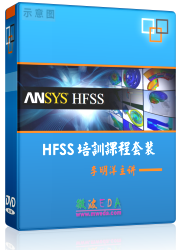Assigning Materials
You can add, remove, and edit materials in two main ways:
• Using the Tools>Edit Configured Libraries>Materials menu command.
• Right-clicking Materials in the project tree and selecting Edit All Libraries.
Editing definitions from the project window does not modify the configured libraries for any particular design. To consider the current design, use the Tools>Edit Configured Libraries option. Doing so ensures that new libraries are added to the configured list for the current design. If you edit materials from this command for the current and then export them, they will also be available to assign to objects in other designs.
To assign a material to an object, follow this general procedure:
1. Select the object to which you want to assign a material.
2. Click Modeler>Assign
Material![]() .
.
The Select Definition window appears. When the Show all libraries checkbox is selected, the window lists all of the materials in the global material library as well as the project’s local material library.
You can also open the Select Definition window in one of the following ways:
• In the Properties dialog box for the object, click the material name under the Attributes tab. A drop-down menu shows an Edit... button that opens the Select Definition window.
The menu also lists materials included in the current project. Selecting one of these materials provides another way to assign materials to an object.
• Right-click Model in the project tree, and then click Assign Material on the shortcut menu.
• Right-click the object in the history tree, and then click Assign Material on the shortcut menu.
3. Select a material from the list.
Note |
You can search the listed materials by name or property value. |
If the material you want to assign is not listed, add a new material to the global or local material library, and then select it.
4. Click OK.
The material you chose is assigned to the object.
Note |
For HFSS-IE, problems with dielectrics will generally run more slowly, so HFSS-IE issues a warning for this case. In HFSS-IE: • Only isotropic materials are allowed • Frequency dependent materials are allowed. • No spatial dependent materials are allowed. • You cannot set background material in the solver. Solver assumes vacuum as background material. |
Note |
In the history tree, by default, HFSS groups objects by material. To change the default, select the object icon and right-click to display the Group Objects by Material checkbox. |
Related Topics
Solve Inside or On a Surface
Assigning DC Thickness
Searching for Materials
Adding New Materials
Assigning Material Property Types
Defining Variable Material Properties
Defining Frequency Dependent Material Properties
Defining Material Properties as Expressions
Defining Functional Material Properties
Viewing and Modifying Material Attributes
Validating Materials
Copying Materials
Removing Materials
Export Materials to a Library
Sorting Materials
Filtering Materials
Working with Materials Libraries
Setting the Temperature of Objects
-

国内最全面的HFSS培训课程,包含7套视频教程和2本教材,资深专家讲解,视频操作演示,结合最新工程案例,让HFSS学习不再难...【详细介绍】





